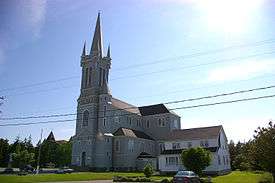Église Sainte-Marie, Church Point, Nova Scotia

Église Sainte-Marie is a Catholic church in Church Point, Nova Scotia, Canada. It is one of the largest and tallest wooden buildings in North America. Built in the form of a cross, the church nave measures 58 metres (190 feet) in length, with transepts that are 41 metres (135 feet) across. The church spire rises 56 metres (184 feet) from floor to steeple, with its cross adding another 1.67 meters (5.5 feet). Originally 15 feet taller, the church steeple was struck by lightning in 1914, requiring part of the spire to be rebuilt.
History
The first church built in the Church Point area, part of Nova Scotia's French Shore, was at Grosses Coques. Built in 1774, it was a rough chapel to serve the needs of Acadians returning from Massachusetts following the Great Upheaval, the deportation of the Acadians. A second chapel was built in 1786 on a point of land jutting into St. Mary's Bay, giving rise to the name "Church Point".
A third church was built following the arrival of Jean-Mandé Sigogne, the first resident priest. This church was built along the main road in the community, where the parish cemetery is now located, rather than on the point. It burned down in September 1820. It was rebuilt in a classical Georgian style, and served the community from 1829 to 1905, when the present church was opened.[1]
Construction on the present church began in 1903. Father Pierre-Marie Dagnaud, a Eudist Roman Catholic priest, was appointed the head of Collège Sainte-Anne in 1899, thereby becoming the parish priest of St. Mary's. He decided on the construction of a grand church, and hired Auguste Regneault of Rennes, France as his architect. The church was built by master carpenter Léo Melanson, with the assistance of 1500 parishioners.
Construction
The design of the church was influenced by the architecture of the famous chateaux of the Loire Valley and by the design of the church in Father Dagnaud's home town of Bains-sur-Ouste, France. The central steeple is flanked by a pair of turrets, with four more turrets surrounding the spire.
The church is exposed to the strong winds from St. Mary's Bay, so 40 tons of stone ballast were used to stabilize the steeple, and canvas, rather than plaster, was used for the walls.
The steeple holds three bronze bells imported from France, the largest weighing almost 800 kilograms.
Interior
The interior of Église Sainte-Marie features a high, vaulted ceiling lit by a row of clerestory windows, below which runs a band of Romanesque arches around the church. The walls are painted white, and nine flower edged tableaux are painted on the central ceiling vaults. White oak pews have replaced the original chairs that were used for seating.
The church attracts thousands of tourists annually, and a museum room that is open to the public was established inside the church in 1970. The museum features a reliquary handcrafted by an Acadian artist from the region and a collection of religious and liturgical artifacts.
Notes
- ↑ see Boudreau, Gérald C., Le père Sigogne et les Acadiens du sud-ouest de la Nouvelle-Écosse, Montréal (Québec), Les Éditions Bellarmin, mai 1992, 230 p.
References
- Pacey, Elizabeth (1983). More Stately Mansions: Churches of Nova Scotia 1830–1910. Lancelot Press Ltd.
- Pacey, Elizabeth and Comiter, Alan (1994). Landmarks: Historic Buildings of Nova Scotia. Nimbus Publishing Ltd.
External links
Coordinates: 44°20′2.9″N 66°6′57.8″W / 44.334139°N 66.116056°W